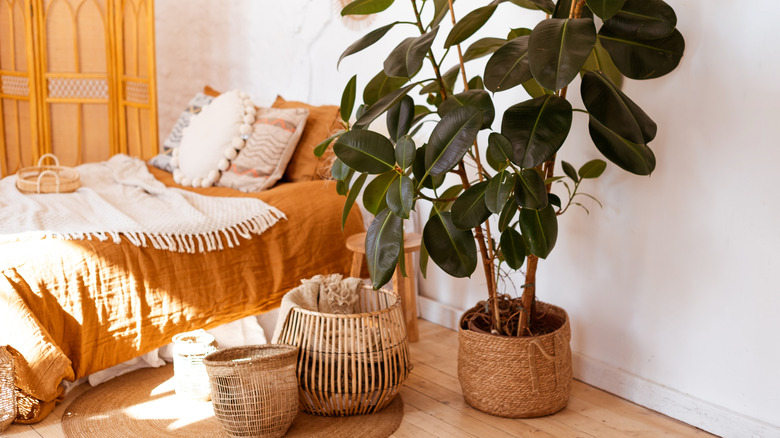Get A Fuller Rubber Tree Plant With TikTok's Clever Potting Hack
Rubber trees make a beautiful addition to a bare corner with their interesting height and dark, oblong leaves. Indoors, they can reach heights of up to 10 feet with optimal care. Unfortunately, this type of plant is known to become wanting or bare around the trunk as it gets taller due to a phenomenon called apical dominance. Apical dominance is when the main stem or central leader of a plant inhibits the growth of lateral branches. In the case of rubber trees, the apical bud at the top of the tree releases hormones that suppress the growth of lower branches. As a result, the lower branches receive less sunlight and nutrients, causing them to become sparse or leggy. As the plant climbs in height, the aesthetic may be less enjoyable as the leaves will be mostly concentrated toward the top of the plant, bearing a somewhat naked appearance below. One solution to this problem is actually planting multiple trees together in the same pot.
Growing rubber trees in the same pot is a clever idea because it helps to create a fuller and more aesthetically pleasing appearance. By planting multiple trees together, the legginess produced by apical dominance is reduced, resulting in a denser foliage distribution throughout the plant. This also creates a more balanced and symmetrical look. So if you feel like your rubber tree is beginning to look slim toward the bottom, adding a second tree to keep it company may be your best solution.
How to plant multiple plants together safely
To create a fuller look by planting multiple rubber trees together, there are specific steps you should follow to ensure that it's done safely without sacrificing the health of either plant for aesthetic purposes. Choose a pot that is large enough to accommodate multiple rubber trees comfortably. Ensure that the pot has drainage holes to prevent waterlogging, which can lead to root rot.
Use a well-draining potting mix rich in organic matter. A mix of potting soil and perlite for drainage can be a good choice. Carefully remove the rubber tree saplings from their individual pots, taking care not to damage the roots. Gently loosen the root ball to encourage growth. Repot the rubber tree saplings in the pot, ensuring that they are evenly spaced and have enough room to grow. Avoid overcrowding their roots, as this can lead to competition for resources, hindering growth.
Gradually fill the pot with the prepared potting mix, ensuring that the roots of the saplings are covered adequately. Gently press the soil around the base of each sapling to provide stability. After planting, thoroughly water the pot to settle the soil and ensure good root-to-soil contact. Avoid overwatering, as this can lead to root rot. Allow the soil to dry slightly between watering sessions. Finally, place the pot in a location that receives bright, indirect sunlight. Rubber trees thrive in warm and humid conditions, so ensure that the temperature and humidity levels are suitable. In TikTok user @pinkyonthegreen's video, she uses a long wooden stake to secure her larger rubber plant in place, which is a good strategy for keeping huge rubber plants upright.
